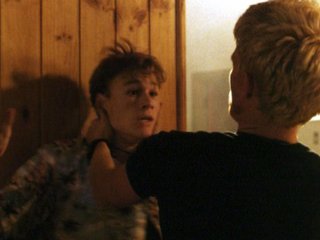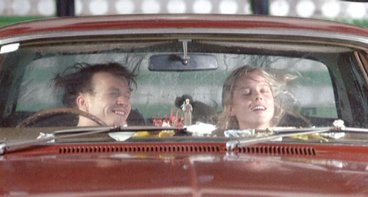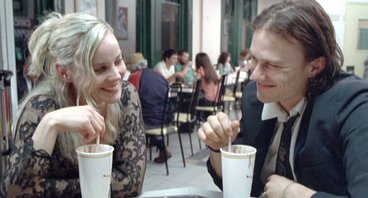Heath Ledger
4 April 1979 – 22 January 2008

See also
- 2000s
- Academy Awards
- actors
- cowboys
- dancers
- directors
- film stars
- Hollywood
- Ned Kelly
- rock music
- singers
- Western Australia
Related people
Related events
NFSA Historian Graham Shirley writes that Heath Ledger’s career and life were tragically cut short, but his international success and the calibre of his performances will endure the test of time.
Few Australian film actors have had swift journeys to international stardom – Errol Flynn in the 1930s, Rod Taylor in the 1950s, Mel Gibson in the ‘80s and Heath Ledger in the ‘90s and early 2000s are the ones that immediately spring to mind. Ledger’s rapid rise was due to a combination of his talent, determination, looks, voice and a resolve to embrace the diversity of that most durable of performers, the character actor. It would have been easy for Ledger to keep repeating himself in high school roles similar to his Hollywood debut, 10 Things I Hate About You (1999), but that was not the way he saw life.
Ledger was born on 4 April 1979 in Perth, Western Australia, the son of Kim Ledger, an engineer, and Sally Ledger (nee Ramshaw), a haematology technician, who named him after Heathcliff, the hero of Emily Bronte’s Wuthering Heights (1847). They had already named an older daughter Katherine (Kate, born in 1975) after the heroine of that novel, and it was Kate who encouraged Heath’s acting for theatre at the same time as he was excelling at school sports.
Following his stage debut at the age of ten, Ledger appeared as an unbilled extra in the feature Clowning Around (George Whaley, 1992), and had his first television work in two episodes of the TV series Ship to Shore (Barron Entertainment, 1993–94). As a teenager, Ledger sparked attention by appearing as a gay cyclist in the 26-part TV series Sweat (Barron Entertainment, 1996). Just after turning 17, Ledger and a friend drove from Perth to Sydney in search of the broader opportunities provided by Australia’s east coast film and TV industries.
In 1997 Ledger played supports in the films Blackrock (Steven Vidler, 1997) and Paws (Karl Zwicky, 1997), and a wild schoolboy in several episodes of the TV drama series Home and Away (Seven Network, 1987–current). His first starring role was in the US-backed fantasy TV series Roar (Sea Change Productions, 1997), filmed in Queensland and featuring Ledger as a Celtic prince in ancient Britain. While the series rated poorly in the US, it gave Ledger all-important camera experience and, at the series’ conclusion, he followed his co-star Lisa Zane (sister of actor Billy Zane) back to Los Angeles.
Ledger initially found no work in America despite having a US agent, and it was the offer to appear in the Australian feature Two Hands (Gregor Jordan, 1999) that brought him stardom and recognition on both sides of the Pacific. Ledger played Jimmy, the small-time crim in Two Hands, with equal measures of humble anti-hero and charisma. His scenes with fellow newcomer Rose Byrne had a palpable on-screen magic as their characters went on the run from gang thugs.
He was next cast in the Hollywood film 10 Things I Hate About You (Gil Junger, 1999), a modern re-working of Shakespeare’s The Taming of the Shrew. It gave Ledger the chance to verbally joust with co-star Julia Styles as well as to sing and dance (he was a lifelong fan of singer-dancer-actor Gene Kelly). The film was an ideal showcase for Ledger’s talents and proved a box-office smash. But like Johnny Depp, whose work he admired, Ledger had no wish to be typecast as a perpetual teen, and he spent a year rejecting similar scripts while living without income in Laurel Canyon.
After a jittery audition and nearly being beaten to the role by Ryan Phillippe, he truly established himself with American audiences when cast as Mel Gibson’s eldest son in the War of Independence epic The Patriot (Roland Emmerich, 2000). Ledger made the most of his second billing, being able to make an impact as much through the subtlety as the strength of his performance.
Columbia Pictures, who had backed The Patriot, next planned stardom for Ledger as the lead in the light-hearted medieval saga A Knight’s Tale (Brian Helgeland, 2001). The film showed Ledger as a playful yet authoritative leading man fully capable of being the type of dashing hero that had been a specialty of Errol Flynn. Defiantly anachronistic and promoting its leads in rock star terms, the film netted USD$56 million in the US alone. While he enjoyed the making of A Knight’s Tale, Ledger subsequently railed at what he saw as the artificial star trappings manufactured around him on this film, especially at a meeting with Columbia publicists and marketing experts who talked about 'how they were planning to promote me as a product’.
Monster’s Ball (Marc Forster, 2001) showed what a fine character actor Ledger could be in his role as the sensitive, bottled-up son of an abusive prison warder. His character’s suicide 35 minutes into the story has a shattering impact that resonates through the rest of the Oscar-winning film.
His next couple of films, the sixth screen version of The Four Feathers (Shekhar Kapur, 2002) and The Sin Eater (Brian Helgeland, 2003), were box-office misfires. Ledger acquitted himself earnestly as the Four Feathers hero who redeems himself from accusations of cowardice, but the film’s solemnity and excessive length made it seem like an epic relic from the 1960s. Kim Ledger recalls that the film’s release was delayed by the chaotic aftermath of the September 2001 terrorist attacks in the US, and that the film received minimal publicity when it was eventually screened.
Ledger’s second Australian feature, Ned Kelly (Gregor Jordan, 2003), failed to recapture the chemistry that star and director had achieved with Two Hands. This film – the seventh feature telling of the real-life Kelly gang story – was a downbeat affair that presented little that was new for a contemporary audience.
Back in the US, Lords of Dogtown (Catherine Hardwicke, 2005) drew another good performance from Ledger in his first genuinely adult role as a burnt-out hippie in a fictionalised account of the birth of skateboarding in Venice, California, in the mid-1970s. This role, and his next as a dreamy version of German writer Jacob Grimm in The Brothers Grimm (Terry Gilliam, 2005), again testified to the actor’s resolve never to repeat himself.
For director Ang Lee, Ledger generated great impact in Brokeback Mountain (2005), a film of thwarted love in which he played a gay cowboy in love with a fellow farmhand (Jake Gyllenhaal). His character, Ennis Del Mar, was largely introspective, given to little dialogue and was therefore a challenge for the actor to reflect physically the role’s isolation, fear, awakening sexuality and masking of associated emotions through a tough exterior and moments of violence. It was the biggest risk and most demanding role of Ledger’s career, and Brokeback Mountain earned him best actor awards from the New York Film Critics’ Circle and the San Francisco Film Critics’ Circle, besides best actor nominations in the Golden Globe Awards and Academy Awards. Britain’s The Observer praised Ledger’s and Gyllenhaal’s ‘excellent, complementary performances’, while Empire magazine found Ledger the film’s ‘real revelation’. The New York Times wrote: ‘Mr Ledger magically and mysteriously disappears beneath the skin of his lean, sinewy character. It is a great screen performance, as good as the best of Marlon Brando and Sean Penn.’
Ledger returned to Australia. Playing opposite Abbie Cornish, he invested strong emotional truth into his role as a heroin addict in the love story Candy (Neil Armfield, 2006). Variety’s review judged that the film ‘belongs to Heath Ledger … (who) convincingly adds to his repertoire with a warm depiction of the charmingly co-dependent Dan who both fuels and fears the addiction of his girlfriend’. After such serious work, he accepted the title role of the notorious 18th century Venetian womaniser Casanova (Lasse Hallström, 2006) as an opportunity to relax as well as work with a director he admired in what was a deliberately over-the-top romantic comedy. But it was back to intensity with I’m Not There (Todd Haynes, 2007), in which Ledger was one of six actors portraying different aspects of a Bob Dylan-type character. Ledger’s role in the film was that of Robbie, a moody actor playing in a mid-1960s film about Dylan. Rolling Stone judged that Ledger ‘digs deep into the challenging role’, while the San Francisco Chronicle observed that Ledger’s role was that of ‘the celebrity Dylan, the one who must deal with the temptations and pressures of fame’.
Ledger’s next film took him into even more edgy territory, that of the psychopathic Joker in the Batman film The Dark Knight (Christopher Nolan, 2008). The Joker of Nolan’s film was a multilayered and complex character very far from Jack Nicholson’s comic turn in the role for the 1989 Batman film directed by Tim Burton. At their first meeting for the film, Ledger and Nolan envisaged a Joker inspired by Stanley Kubrick’s A Clockwork Orange (1971). Kim Ledger recalls that Heath Ledger and Nolan ‘were both on the same wavelength at this point. Some of Kubrick’s crazy nastiness was later embedded in the Joker but with other bizarre layers of psychotic behaviour.’ Four months before filming, Ledger started keeping a diary imagining the Joker’s inner thoughts, and for the month before the shoot he lived in seclusion in a London hotel room to further think his way into the role.
In 2007 Heath Ledger’s three-year partnership with actress Michelle Williams – a union that had produced a daughter, Matilda Rose (born 2005) – came to an end, a separation that caused considerable heartache. In early 2008 Ledger was suffering from acute pneumonia and insomnia triggered by his intense absorption in his film roles and seven days of night shoots for the London scenes he completed for The Imaginarium of Doctor Parnassus (Terry Gilliam, 2009). Remarkably, none of this showed in Ledger’s Parnassus scenes, which were among the most lighthearted he ever delivered.
But on the afternoon of 22 January 2008, Heath Ledger was found unconscious in his New York apartment, and at 3.36 pm he was pronounced dead. At the end of an investigation, the New York Medical Examiner ruled that he had died from an accidental toxic combination of prescription drugs. Private memorial ceremonies were conducted in Los Angeles, after which Heath Ledger’s family accompanied his body to Perth, where there was a memorial service for family and invited guests.
The following month, as a tribute to Ledger, Johnny Depp, Jude Law and Colin Farrell signed on to take his place for the scenes he had yet to film for The Imaginarium of Doctor Parnassus. The film’s new plot device of physical appearance transformations each time the character entered Parnassus’s magical mirror worked well; all of Ledger’s Parnassus scenes so far had been exterior ones, and those with the new actors took place in fantasy worlds shot on green screen in Vancouver.
In July, the highly anticipated The Dark Knight opened to rave reviews, and the Guardian judged Ledger’s performance a tremendous one. ‘His great grin, though enhanced by rouge, has evidently been caused by two horrid slash-scars to the corners of his mouth, and his whiteface makeup is always cracking and peeling off, perhaps due to the dried remnants of tears, making him look like some self-hating Pagliaccio (sic) of crime, sweating backstage after the latest awful spectacular.’
The Dark Knight won Ledger a posthumous Academy Award and a Golden Globe for Best Supporting Actor, with the Oscar being the first posthumous one awarded to an actor since fellow Australian Peter Finch won Best Performance for a Leading Actor for Network (Sidney Lumet, 1976).
Late 2009 marked the release of The Imaginarium of Doctor Parnassus. Most critics agreed on the power of Ledger’s final role; The Washington Post’s Ann Hornaday praised his work saying he ‘stays on the scene, in a performance that bears no trace of having been truncated, trimmed or torturously edited’.
Heath Ledger’s early death makes one lament the roles he would never go on to play. He left behind 18 films, all of them as different from the others as he could have wished. Where his Australian predecessors in Hollywood – Errol Flynn, Rod Taylor and Mel Gibson – had mostly played variations on a character identified with them as people, Ledger’s commitment to the challenging world of the character actor had taken him along many more roads.
Ledger’s passing occurred with no record or history of his life having been captured within an oral history context. His life and death has inspired the NFSA, in partnership with major arts tertiary education institutions, to launch the Heath Ledger Young Artists Oral History Project to conduct on-camera interviews with students in their graduating year, with follow-up interviews scheduled at regular intervals. This material will serve as a record of the artists’ careers, and will also be used for education and training purposes. For more information visit The Heath Ledger Young Artists Oral History Project.
External Links
Citations
- Aussiewood: Australia’s Leading Actors and Directors Tell How they Conquered Hollywood (2004)
Boland, Michaela and Michael Bodey
Crows Nest, Sydney: Allen and Unwin - Correspondence (2011)
Ledger, Kim - Heath Ledger: Hollywood’s Dark Star (2008)
Robb, Brian J
Prahran, Victoria: Hardie Grant Books
- Titles
- Portrait
- Extras
- Screenography







